Marks & Spencer: Organizational Behavior Report, Unit 12 Analysis
VerifiedAdded on 2023/01/17
|17
|5233
|64
Report
AI Summary
This report delves into the realm of organizational behavior, using Marks & Spencer as a case study to explore the influence of organizational culture, power dynamics, and political landscapes on individual and team performance. It examines various motivational theories, including content and process theories, to understand how they impact employee behavior and drive organizational success. The report also differentiates between effective and ineffective teams, analyzing relevant team and group development theories to foster dynamic cooperation within the workplace. Furthermore, it applies key concepts and philosophies related to organizational behavior, providing a critical analysis of their effects on workplace conduct and offering recommendations to enhance team and organizational effectiveness. The report incorporates frameworks like Handy's typology and Hofstede's cultural dimensions to provide a comprehensive understanding of the subject matter.
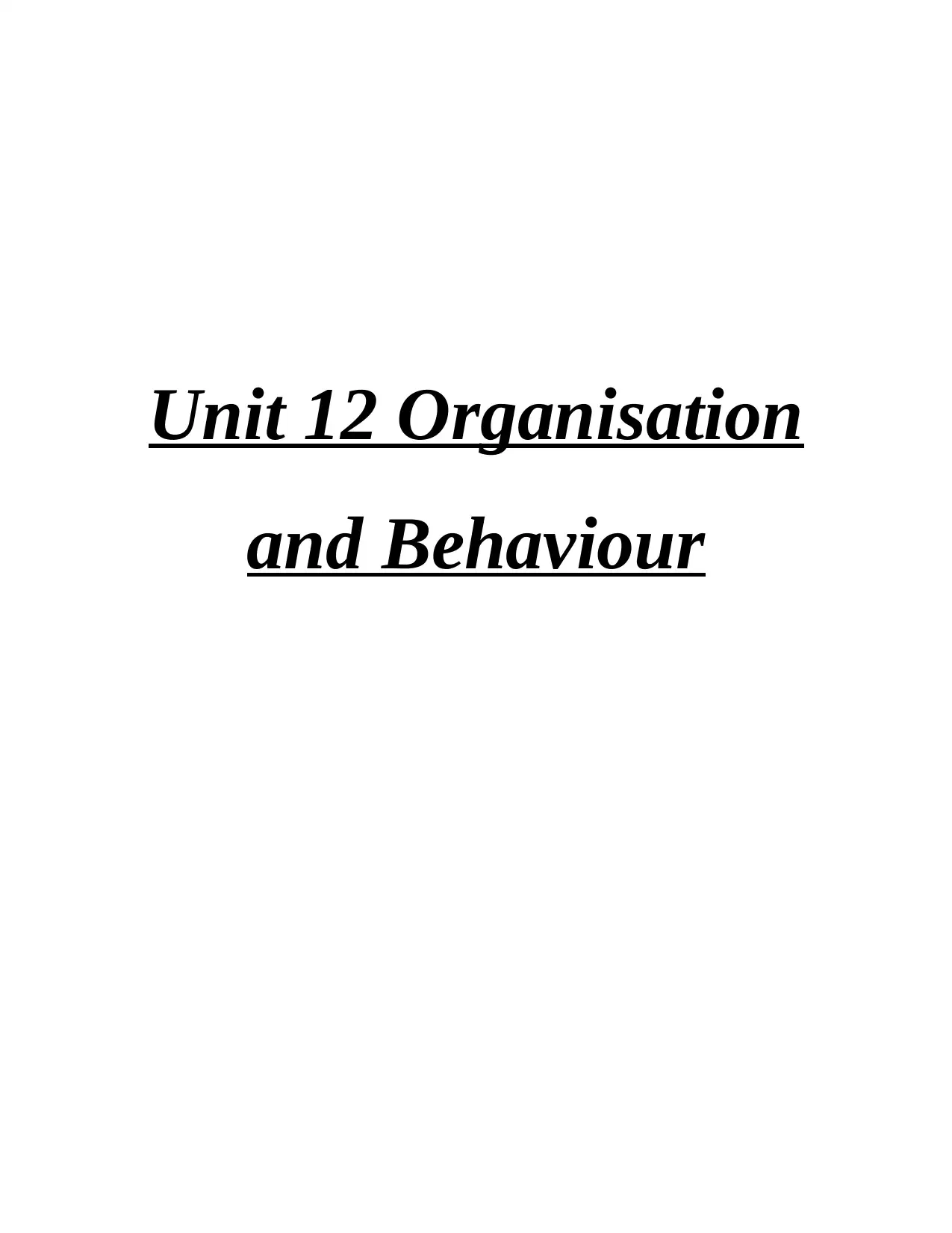
Unit 12 Organisation
and Behaviour
and Behaviour
Paraphrase This Document
Need a fresh take? Get an instant paraphrase of this document with our AI Paraphraser
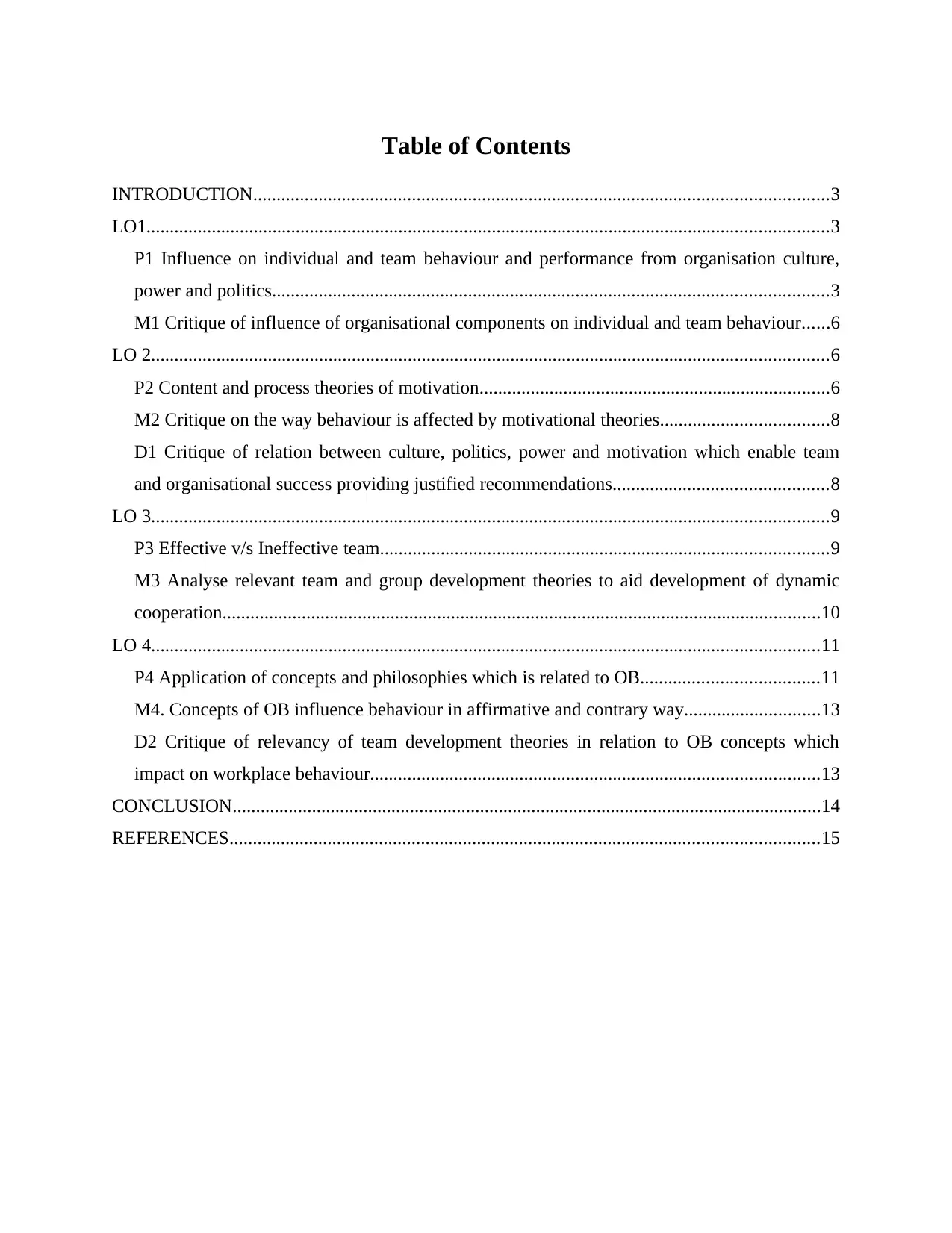
Table of Contents
INTRODUCTION...........................................................................................................................3
LO1..................................................................................................................................................3
P1 Influence on individual and team behaviour and performance from organisation culture,
power and politics.......................................................................................................................3
M1 Critique of influence of organisational components on individual and team behaviour......6
LO 2.................................................................................................................................................6
P2 Content and process theories of motivation...........................................................................6
M2 Critique on the way behaviour is affected by motivational theories....................................8
D1 Critique of relation between culture, politics, power and motivation which enable team
and organisational success providing justified recommendations..............................................8
LO 3.................................................................................................................................................9
P3 Effective v/s Ineffective team................................................................................................9
M3 Analyse relevant team and group development theories to aid development of dynamic
cooperation................................................................................................................................10
LO 4...............................................................................................................................................11
P4 Application of concepts and philosophies which is related to OB......................................11
M4. Concepts of OB influence behaviour in affirmative and contrary way.............................13
D2 Critique of relevancy of team development theories in relation to OB concepts which
impact on workplace behaviour................................................................................................13
CONCLUSION..............................................................................................................................14
REFERENCES..............................................................................................................................15
INTRODUCTION...........................................................................................................................3
LO1..................................................................................................................................................3
P1 Influence on individual and team behaviour and performance from organisation culture,
power and politics.......................................................................................................................3
M1 Critique of influence of organisational components on individual and team behaviour......6
LO 2.................................................................................................................................................6
P2 Content and process theories of motivation...........................................................................6
M2 Critique on the way behaviour is affected by motivational theories....................................8
D1 Critique of relation between culture, politics, power and motivation which enable team
and organisational success providing justified recommendations..............................................8
LO 3.................................................................................................................................................9
P3 Effective v/s Ineffective team................................................................................................9
M3 Analyse relevant team and group development theories to aid development of dynamic
cooperation................................................................................................................................10
LO 4...............................................................................................................................................11
P4 Application of concepts and philosophies which is related to OB......................................11
M4. Concepts of OB influence behaviour in affirmative and contrary way.............................13
D2 Critique of relevancy of team development theories in relation to OB concepts which
impact on workplace behaviour................................................................................................13
CONCLUSION..............................................................................................................................14
REFERENCES..............................................................................................................................15
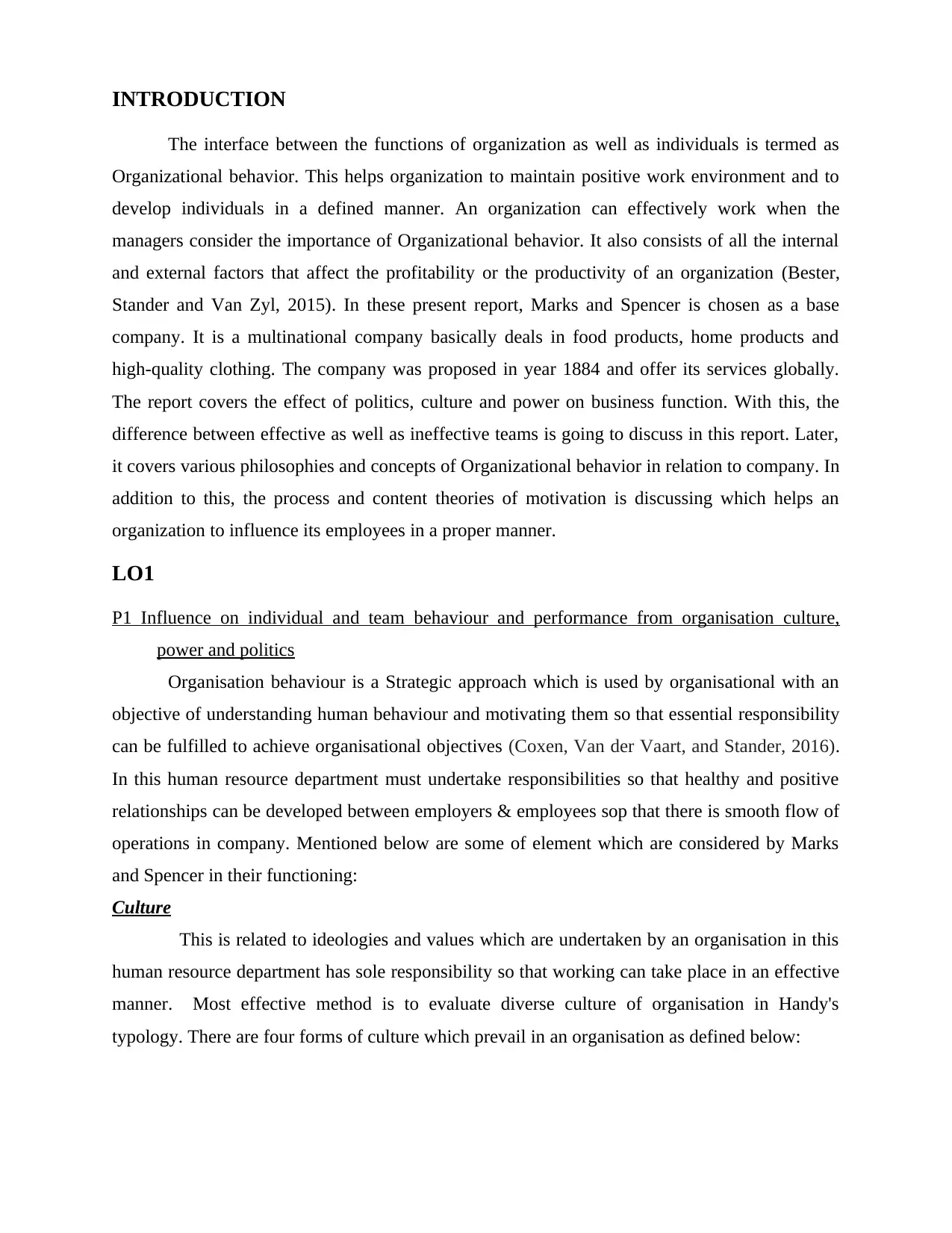
INTRODUCTION
The interface between the functions of organization as well as individuals is termed as
Organizational behavior. This helps organization to maintain positive work environment and to
develop individuals in a defined manner. An organization can effectively work when the
managers consider the importance of Organizational behavior. It also consists of all the internal
and external factors that affect the profitability or the productivity of an organization (Bester,
Stander and Van Zyl, 2015). In these present report, Marks and Spencer is chosen as a base
company. It is a multinational company basically deals in food products, home products and
high-quality clothing. The company was proposed in year 1884 and offer its services globally.
The report covers the effect of politics, culture and power on business function. With this, the
difference between effective as well as ineffective teams is going to discuss in this report. Later,
it covers various philosophies and concepts of Organizational behavior in relation to company. In
addition to this, the process and content theories of motivation is discussing which helps an
organization to influence its employees in a proper manner.
LO1
P1 Influence on individual and team behaviour and performance from organisation culture,
power and politics
Organisation behaviour is a Strategic approach which is used by organisational with an
objective of understanding human behaviour and motivating them so that essential responsibility
can be fulfilled to achieve organisational objectives (Coxen, Van der Vaart, and Stander, 2016).
In this human resource department must undertake responsibilities so that healthy and positive
relationships can be developed between employers & employees sop that there is smooth flow of
operations in company. Mentioned below are some of element which are considered by Marks
and Spencer in their functioning:
Culture
This is related to ideologies and values which are undertaken by an organisation in this
human resource department has sole responsibility so that working can take place in an effective
manner. Most effective method is to evaluate diverse culture of organisation in Handy's
typology. There are four forms of culture which prevail in an organisation as defined below:
The interface between the functions of organization as well as individuals is termed as
Organizational behavior. This helps organization to maintain positive work environment and to
develop individuals in a defined manner. An organization can effectively work when the
managers consider the importance of Organizational behavior. It also consists of all the internal
and external factors that affect the profitability or the productivity of an organization (Bester,
Stander and Van Zyl, 2015). In these present report, Marks and Spencer is chosen as a base
company. It is a multinational company basically deals in food products, home products and
high-quality clothing. The company was proposed in year 1884 and offer its services globally.
The report covers the effect of politics, culture and power on business function. With this, the
difference between effective as well as ineffective teams is going to discuss in this report. Later,
it covers various philosophies and concepts of Organizational behavior in relation to company. In
addition to this, the process and content theories of motivation is discussing which helps an
organization to influence its employees in a proper manner.
LO1
P1 Influence on individual and team behaviour and performance from organisation culture,
power and politics
Organisation behaviour is a Strategic approach which is used by organisational with an
objective of understanding human behaviour and motivating them so that essential responsibility
can be fulfilled to achieve organisational objectives (Coxen, Van der Vaart, and Stander, 2016).
In this human resource department must undertake responsibilities so that healthy and positive
relationships can be developed between employers & employees sop that there is smooth flow of
operations in company. Mentioned below are some of element which are considered by Marks
and Spencer in their functioning:
Culture
This is related to ideologies and values which are undertaken by an organisation in this
human resource department has sole responsibility so that working can take place in an effective
manner. Most effective method is to evaluate diverse culture of organisation in Handy's
typology. There are four forms of culture which prevail in an organisation as defined below:
⊘ This is a preview!⊘
Do you want full access?
Subscribe today to unlock all pages.

Trusted by 1+ million students worldwide
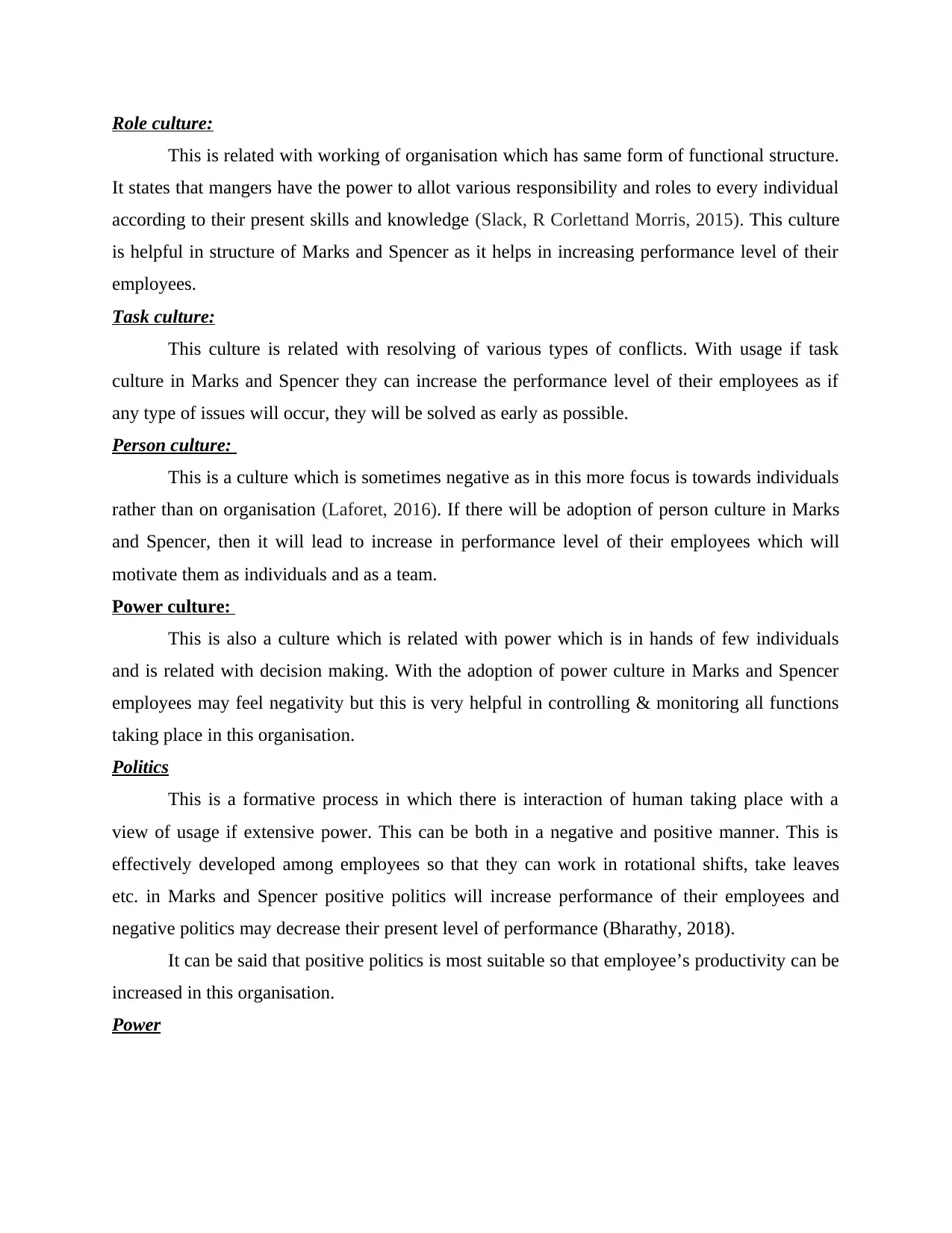
Role culture:
This is related with working of organisation which has same form of functional structure.
It states that mangers have the power to allot various responsibility and roles to every individual
according to their present skills and knowledge (Slack, R Corlettand Morris, 2015). This culture
is helpful in structure of Marks and Spencer as it helps in increasing performance level of their
employees.
Task culture:
This culture is related with resolving of various types of conflicts. With usage if task
culture in Marks and Spencer they can increase the performance level of their employees as if
any type of issues will occur, they will be solved as early as possible.
Person culture:
This is a culture which is sometimes negative as in this more focus is towards individuals
rather than on organisation (Laforet, 2016). If there will be adoption of person culture in Marks
and Spencer, then it will lead to increase in performance level of their employees which will
motivate them as individuals and as a team.
Power culture:
This is also a culture which is related with power which is in hands of few individuals
and is related with decision making. With the adoption of power culture in Marks and Spencer
employees may feel negativity but this is very helpful in controlling & monitoring all functions
taking place in this organisation.
Politics
This is a formative process in which there is interaction of human taking place with a
view of usage if extensive power. This can be both in a negative and positive manner. This is
effectively developed among employees so that they can work in rotational shifts, take leaves
etc. in Marks and Spencer positive politics will increase performance of their employees and
negative politics may decrease their present level of performance (Bharathy, 2018).
It can be said that positive politics is most suitable so that employee’s productivity can be
increased in this organisation.
Power
This is related with working of organisation which has same form of functional structure.
It states that mangers have the power to allot various responsibility and roles to every individual
according to their present skills and knowledge (Slack, R Corlettand Morris, 2015). This culture
is helpful in structure of Marks and Spencer as it helps in increasing performance level of their
employees.
Task culture:
This culture is related with resolving of various types of conflicts. With usage if task
culture in Marks and Spencer they can increase the performance level of their employees as if
any type of issues will occur, they will be solved as early as possible.
Person culture:
This is a culture which is sometimes negative as in this more focus is towards individuals
rather than on organisation (Laforet, 2016). If there will be adoption of person culture in Marks
and Spencer, then it will lead to increase in performance level of their employees which will
motivate them as individuals and as a team.
Power culture:
This is also a culture which is related with power which is in hands of few individuals
and is related with decision making. With the adoption of power culture in Marks and Spencer
employees may feel negativity but this is very helpful in controlling & monitoring all functions
taking place in this organisation.
Politics
This is a formative process in which there is interaction of human taking place with a
view of usage if extensive power. This can be both in a negative and positive manner. This is
effectively developed among employees so that they can work in rotational shifts, take leaves
etc. in Marks and Spencer positive politics will increase performance of their employees and
negative politics may decrease their present level of performance (Bharathy, 2018).
It can be said that positive politics is most suitable so that employee’s productivity can be
increased in this organisation.
Power
Paraphrase This Document
Need a fresh take? Get an instant paraphrase of this document with our AI Paraphraser
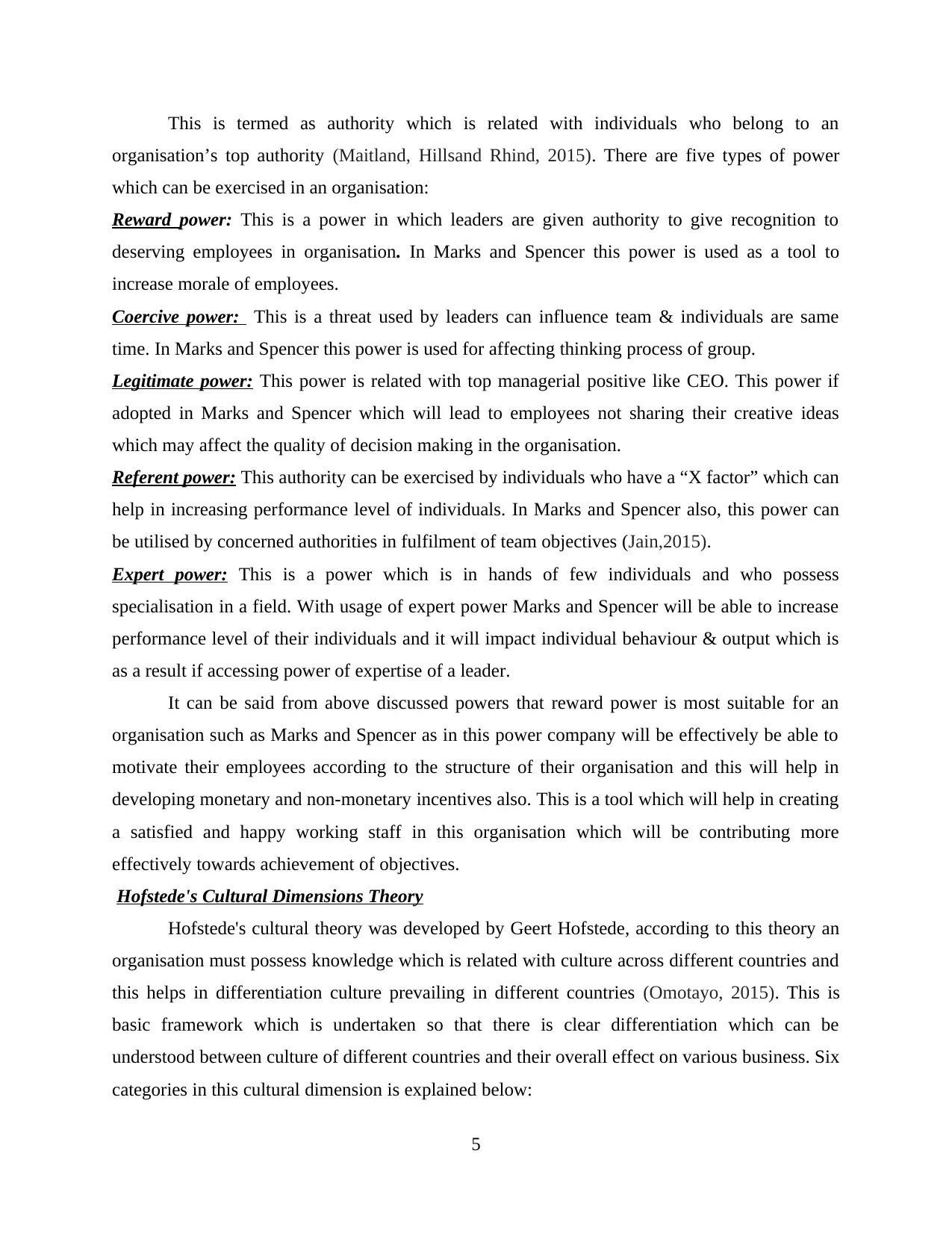
This is termed as authority which is related with individuals who belong to an
organisation’s top authority (Maitland, Hillsand Rhind, 2015). There are five types of power
which can be exercised in an organisation:
Reward power: This is a power in which leaders are given authority to give recognition to
deserving employees in organisation. In Marks and Spencer this power is used as a tool to
increase morale of employees.
Coercive power: This is a threat used by leaders can influence team & individuals are same
time. In Marks and Spencer this power is used for affecting thinking process of group.
Legitimate power: This power is related with top managerial positive like CEO. This power if
adopted in Marks and Spencer which will lead to employees not sharing their creative ideas
which may affect the quality of decision making in the organisation.
Referent power: This authority can be exercised by individuals who have a “X factor” which can
help in increasing performance level of individuals. In Marks and Spencer also, this power can
be utilised by concerned authorities in fulfilment of team objectives (Jain,2015).
Expert power: This is a power which is in hands of few individuals and who possess
specialisation in a field. With usage of expert power Marks and Spencer will be able to increase
performance level of their individuals and it will impact individual behaviour & output which is
as a result if accessing power of expertise of a leader.
It can be said from above discussed powers that reward power is most suitable for an
organisation such as Marks and Spencer as in this power company will be effectively be able to
motivate their employees according to the structure of their organisation and this will help in
developing monetary and non-monetary incentives also. This is a tool which will help in creating
a satisfied and happy working staff in this organisation which will be contributing more
effectively towards achievement of objectives.
Hofstede's Cultural Dimensions Theory
Hofstede's cultural theory was developed by Geert Hofstede, according to this theory an
organisation must possess knowledge which is related with culture across different countries and
this helps in differentiation culture prevailing in different countries (Omotayo, 2015). This is
basic framework which is undertaken so that there is clear differentiation which can be
understood between culture of different countries and their overall effect on various business. Six
categories in this cultural dimension is explained below:
5
organisation’s top authority (Maitland, Hillsand Rhind, 2015). There are five types of power
which can be exercised in an organisation:
Reward power: This is a power in which leaders are given authority to give recognition to
deserving employees in organisation. In Marks and Spencer this power is used as a tool to
increase morale of employees.
Coercive power: This is a threat used by leaders can influence team & individuals are same
time. In Marks and Spencer this power is used for affecting thinking process of group.
Legitimate power: This power is related with top managerial positive like CEO. This power if
adopted in Marks and Spencer which will lead to employees not sharing their creative ideas
which may affect the quality of decision making in the organisation.
Referent power: This authority can be exercised by individuals who have a “X factor” which can
help in increasing performance level of individuals. In Marks and Spencer also, this power can
be utilised by concerned authorities in fulfilment of team objectives (Jain,2015).
Expert power: This is a power which is in hands of few individuals and who possess
specialisation in a field. With usage of expert power Marks and Spencer will be able to increase
performance level of their individuals and it will impact individual behaviour & output which is
as a result if accessing power of expertise of a leader.
It can be said from above discussed powers that reward power is most suitable for an
organisation such as Marks and Spencer as in this power company will be effectively be able to
motivate their employees according to the structure of their organisation and this will help in
developing monetary and non-monetary incentives also. This is a tool which will help in creating
a satisfied and happy working staff in this organisation which will be contributing more
effectively towards achievement of objectives.
Hofstede's Cultural Dimensions Theory
Hofstede's cultural theory was developed by Geert Hofstede, according to this theory an
organisation must possess knowledge which is related with culture across different countries and
this helps in differentiation culture prevailing in different countries (Omotayo, 2015). This is
basic framework which is undertaken so that there is clear differentiation which can be
understood between culture of different countries and their overall effect on various business. Six
categories in this cultural dimension is explained below:
5
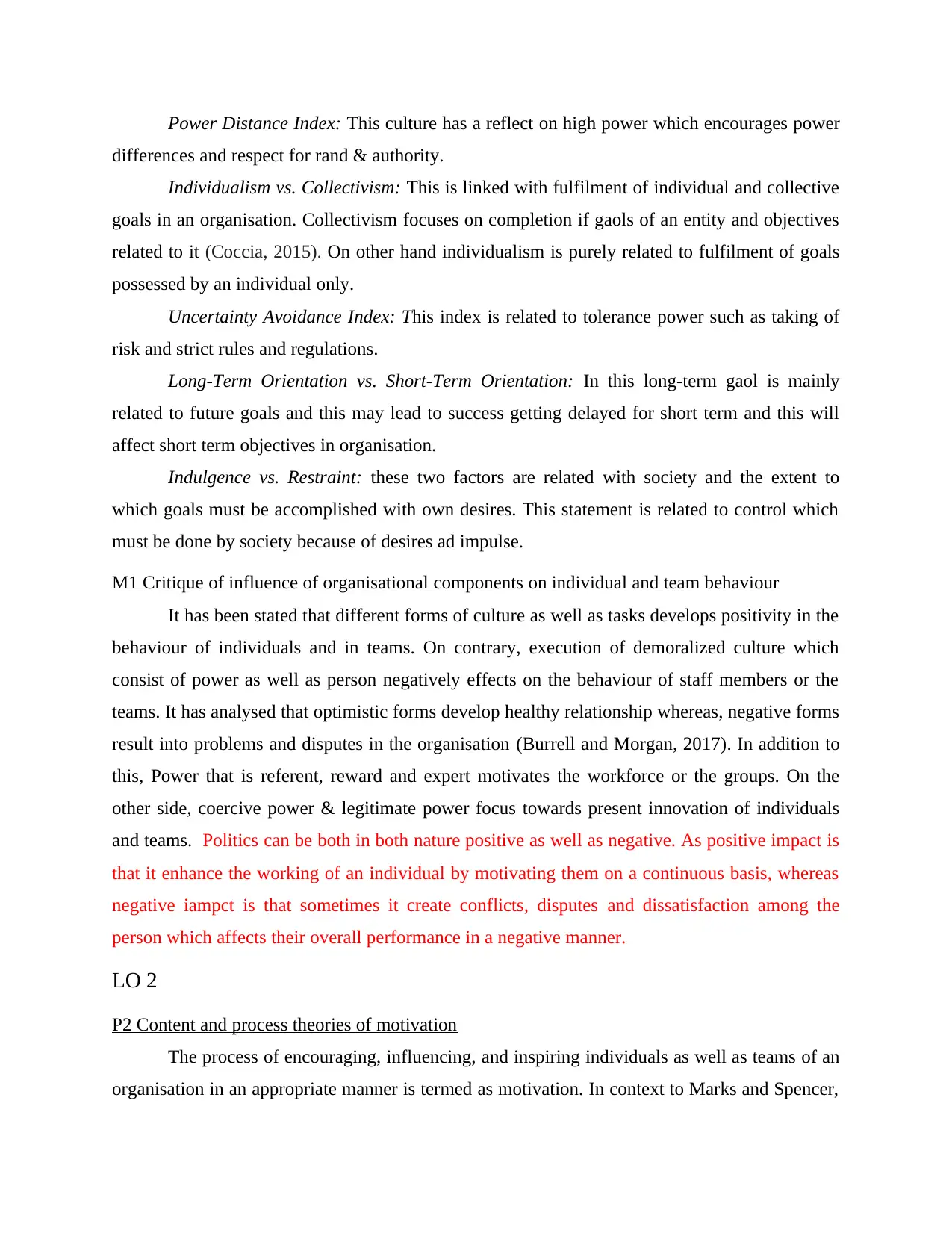
Power Distance Index: This culture has a reflect on high power which encourages power
differences and respect for rand & authority.
Individualism vs. Collectivism: This is linked with fulfilment of individual and collective
goals in an organisation. Collectivism focuses on completion if gaols of an entity and objectives
related to it (Coccia, 2015). On other hand individualism is purely related to fulfilment of goals
possessed by an individual only.
Uncertainty Avoidance Index: This index is related to tolerance power such as taking of
risk and strict rules and regulations.
Long-Term Orientation vs. Short-Term Orientation: In this long-term gaol is mainly
related to future goals and this may lead to success getting delayed for short term and this will
affect short term objectives in organisation.
Indulgence vs. Restraint: these two factors are related with society and the extent to
which goals must be accomplished with own desires. This statement is related to control which
must be done by society because of desires ad impulse.
M1 Critique of influence of organisational components on individual and team behaviour
It has been stated that different forms of culture as well as tasks develops positivity in the
behaviour of individuals and in teams. On contrary, execution of demoralized culture which
consist of power as well as person negatively effects on the behaviour of staff members or the
teams. It has analysed that optimistic forms develop healthy relationship whereas, negative forms
result into problems and disputes in the organisation (Burrell and Morgan, 2017). In addition to
this, Power that is referent, reward and expert motivates the workforce or the groups. On the
other side, coercive power & legitimate power focus towards present innovation of individuals
and teams. Politics can be both in both nature positive as well as negative. As positive impact is
that it enhance the working of an individual by motivating them on a continuous basis, whereas
negative iampct is that sometimes it create conflicts, disputes and dissatisfaction among the
person which affects their overall performance in a negative manner.
LO 2
P2 Content and process theories of motivation
The process of encouraging, influencing, and inspiring individuals as well as teams of an
organisation in an appropriate manner is termed as motivation. In context to Marks and Spencer,
differences and respect for rand & authority.
Individualism vs. Collectivism: This is linked with fulfilment of individual and collective
goals in an organisation. Collectivism focuses on completion if gaols of an entity and objectives
related to it (Coccia, 2015). On other hand individualism is purely related to fulfilment of goals
possessed by an individual only.
Uncertainty Avoidance Index: This index is related to tolerance power such as taking of
risk and strict rules and regulations.
Long-Term Orientation vs. Short-Term Orientation: In this long-term gaol is mainly
related to future goals and this may lead to success getting delayed for short term and this will
affect short term objectives in organisation.
Indulgence vs. Restraint: these two factors are related with society and the extent to
which goals must be accomplished with own desires. This statement is related to control which
must be done by society because of desires ad impulse.
M1 Critique of influence of organisational components on individual and team behaviour
It has been stated that different forms of culture as well as tasks develops positivity in the
behaviour of individuals and in teams. On contrary, execution of demoralized culture which
consist of power as well as person negatively effects on the behaviour of staff members or the
teams. It has analysed that optimistic forms develop healthy relationship whereas, negative forms
result into problems and disputes in the organisation (Burrell and Morgan, 2017). In addition to
this, Power that is referent, reward and expert motivates the workforce or the groups. On the
other side, coercive power & legitimate power focus towards present innovation of individuals
and teams. Politics can be both in both nature positive as well as negative. As positive impact is
that it enhance the working of an individual by motivating them on a continuous basis, whereas
negative iampct is that sometimes it create conflicts, disputes and dissatisfaction among the
person which affects their overall performance in a negative manner.
LO 2
P2 Content and process theories of motivation
The process of encouraging, influencing, and inspiring individuals as well as teams of an
organisation in an appropriate manner is termed as motivation. In context to Marks and Spencer,
⊘ This is a preview!⊘
Do you want full access?
Subscribe today to unlock all pages.

Trusted by 1+ million students worldwide
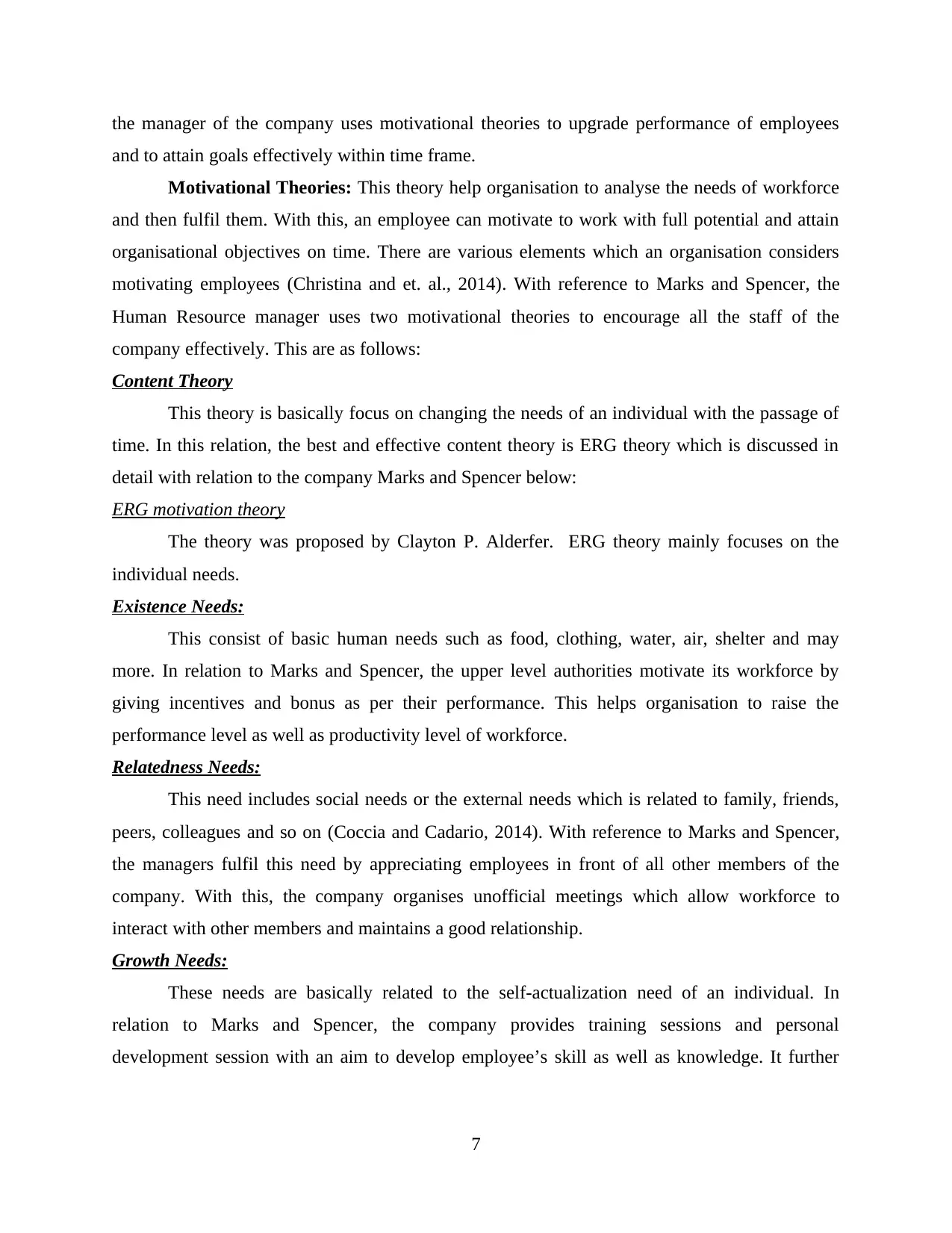
the manager of the company uses motivational theories to upgrade performance of employees
and to attain goals effectively within time frame.
Motivational Theories: This theory help organisation to analyse the needs of workforce
and then fulfil them. With this, an employee can motivate to work with full potential and attain
organisational objectives on time. There are various elements which an organisation considers
motivating employees (Christina and et. al., 2014). With reference to Marks and Spencer, the
Human Resource manager uses two motivational theories to encourage all the staff of the
company effectively. This are as follows:
Content Theory
This theory is basically focus on changing the needs of an individual with the passage of
time. In this relation, the best and effective content theory is ERG theory which is discussed in
detail with relation to the company Marks and Spencer below:
ERG motivation theory
The theory was proposed by Clayton P. Alderfer. ERG theory mainly focuses on the
individual needs.
Existence Needs:
This consist of basic human needs such as food, clothing, water, air, shelter and may
more. In relation to Marks and Spencer, the upper level authorities motivate its workforce by
giving incentives and bonus as per their performance. This helps organisation to raise the
performance level as well as productivity level of workforce.
Relatedness Needs:
This need includes social needs or the external needs which is related to family, friends,
peers, colleagues and so on (Coccia and Cadario, 2014). With reference to Marks and Spencer,
the managers fulfil this need by appreciating employees in front of all other members of the
company. With this, the company organises unofficial meetings which allow workforce to
interact with other members and maintains a good relationship.
Growth Needs:
These needs are basically related to the self-actualization need of an individual. In
relation to Marks and Spencer, the company provides training sessions and personal
development session with an aim to develop employee’s skill as well as knowledge. It further
7
and to attain goals effectively within time frame.
Motivational Theories: This theory help organisation to analyse the needs of workforce
and then fulfil them. With this, an employee can motivate to work with full potential and attain
organisational objectives on time. There are various elements which an organisation considers
motivating employees (Christina and et. al., 2014). With reference to Marks and Spencer, the
Human Resource manager uses two motivational theories to encourage all the staff of the
company effectively. This are as follows:
Content Theory
This theory is basically focus on changing the needs of an individual with the passage of
time. In this relation, the best and effective content theory is ERG theory which is discussed in
detail with relation to the company Marks and Spencer below:
ERG motivation theory
The theory was proposed by Clayton P. Alderfer. ERG theory mainly focuses on the
individual needs.
Existence Needs:
This consist of basic human needs such as food, clothing, water, air, shelter and may
more. In relation to Marks and Spencer, the upper level authorities motivate its workforce by
giving incentives and bonus as per their performance. This helps organisation to raise the
performance level as well as productivity level of workforce.
Relatedness Needs:
This need includes social needs or the external needs which is related to family, friends,
peers, colleagues and so on (Coccia and Cadario, 2014). With reference to Marks and Spencer,
the managers fulfil this need by appreciating employees in front of all other members of the
company. With this, the company organises unofficial meetings which allow workforce to
interact with other members and maintains a good relationship.
Growth Needs:
These needs are basically related to the self-actualization need of an individual. In
relation to Marks and Spencer, the company provides training sessions and personal
development session with an aim to develop employee’s skill as well as knowledge. It further
7
Paraphrase This Document
Need a fresh take? Get an instant paraphrase of this document with our AI Paraphraser
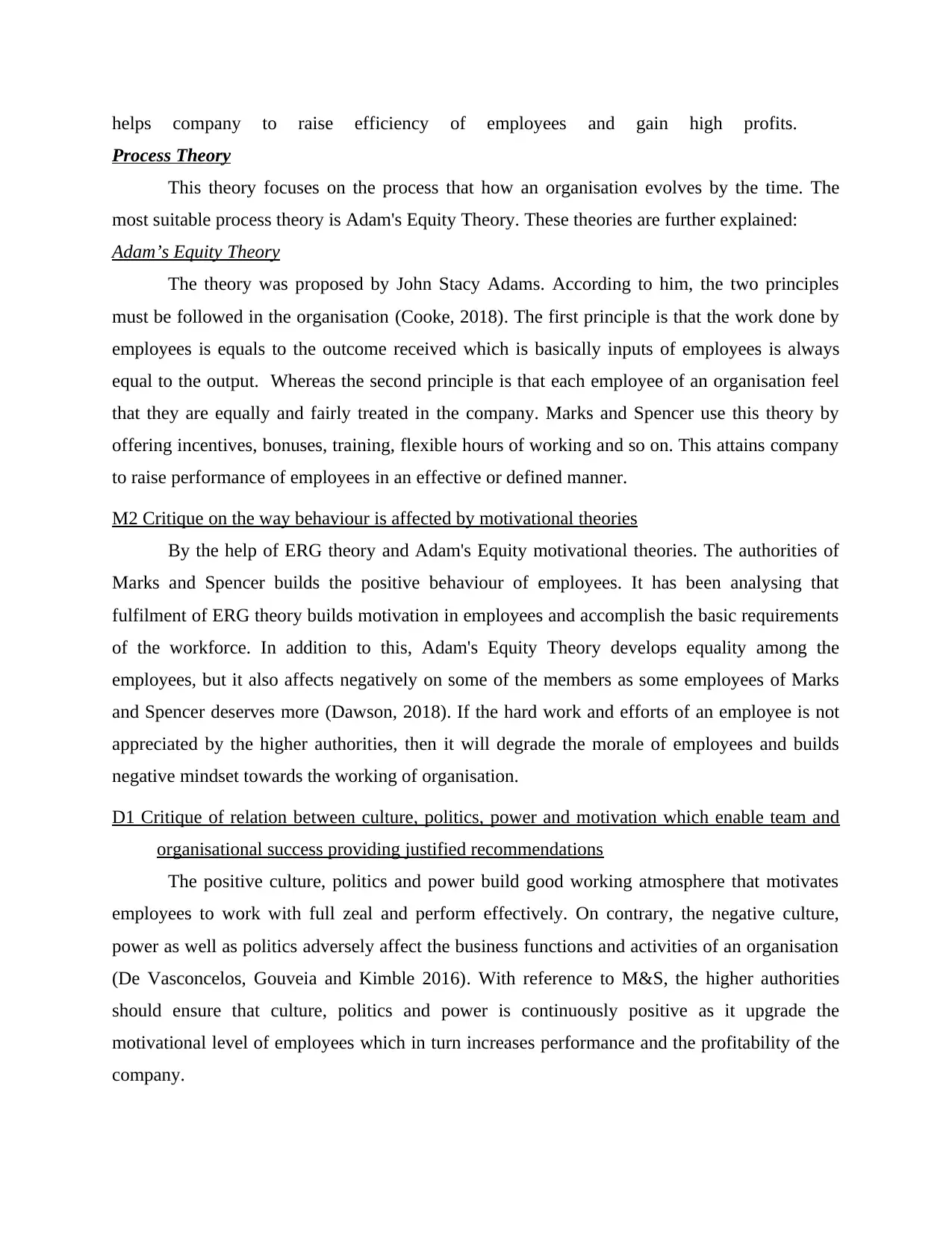
helps company to raise efficiency of employees and gain high profits.
Process Theory
This theory focuses on the process that how an organisation evolves by the time. The
most suitable process theory is Adam's Equity Theory. These theories are further explained:
Adam’s Equity Theory
The theory was proposed by John Stacy Adams. According to him, the two principles
must be followed in the organisation (Cooke, 2018). The first principle is that the work done by
employees is equals to the outcome received which is basically inputs of employees is always
equal to the output. Whereas the second principle is that each employee of an organisation feel
that they are equally and fairly treated in the company. Marks and Spencer use this theory by
offering incentives, bonuses, training, flexible hours of working and so on. This attains company
to raise performance of employees in an effective or defined manner.
M2 Critique on the way behaviour is affected by motivational theories
By the help of ERG theory and Adam's Equity motivational theories. The authorities of
Marks and Spencer builds the positive behaviour of employees. It has been analysing that
fulfilment of ERG theory builds motivation in employees and accomplish the basic requirements
of the workforce. In addition to this, Adam's Equity Theory develops equality among the
employees, but it also affects negatively on some of the members as some employees of Marks
and Spencer deserves more (Dawson, 2018). If the hard work and efforts of an employee is not
appreciated by the higher authorities, then it will degrade the morale of employees and builds
negative mindset towards the working of organisation.
D1 Critique of relation between culture, politics, power and motivation which enable team and
organisational success providing justified recommendations
The positive culture, politics and power build good working atmosphere that motivates
employees to work with full zeal and perform effectively. On contrary, the negative culture,
power as well as politics adversely affect the business functions and activities of an organisation
(De Vasconcelos, Gouveia and Kimble 2016). With reference to M&S, the higher authorities
should ensure that culture, politics and power is continuously positive as it upgrade the
motivational level of employees which in turn increases performance and the profitability of the
company.
Process Theory
This theory focuses on the process that how an organisation evolves by the time. The
most suitable process theory is Adam's Equity Theory. These theories are further explained:
Adam’s Equity Theory
The theory was proposed by John Stacy Adams. According to him, the two principles
must be followed in the organisation (Cooke, 2018). The first principle is that the work done by
employees is equals to the outcome received which is basically inputs of employees is always
equal to the output. Whereas the second principle is that each employee of an organisation feel
that they are equally and fairly treated in the company. Marks and Spencer use this theory by
offering incentives, bonuses, training, flexible hours of working and so on. This attains company
to raise performance of employees in an effective or defined manner.
M2 Critique on the way behaviour is affected by motivational theories
By the help of ERG theory and Adam's Equity motivational theories. The authorities of
Marks and Spencer builds the positive behaviour of employees. It has been analysing that
fulfilment of ERG theory builds motivation in employees and accomplish the basic requirements
of the workforce. In addition to this, Adam's Equity Theory develops equality among the
employees, but it also affects negatively on some of the members as some employees of Marks
and Spencer deserves more (Dawson, 2018). If the hard work and efforts of an employee is not
appreciated by the higher authorities, then it will degrade the morale of employees and builds
negative mindset towards the working of organisation.
D1 Critique of relation between culture, politics, power and motivation which enable team and
organisational success providing justified recommendations
The positive culture, politics and power build good working atmosphere that motivates
employees to work with full zeal and perform effectively. On contrary, the negative culture,
power as well as politics adversely affect the business functions and activities of an organisation
(De Vasconcelos, Gouveia and Kimble 2016). With reference to M&S, the higher authorities
should ensure that culture, politics and power is continuously positive as it upgrade the
motivational level of employees which in turn increases performance and the profitability of the
company.
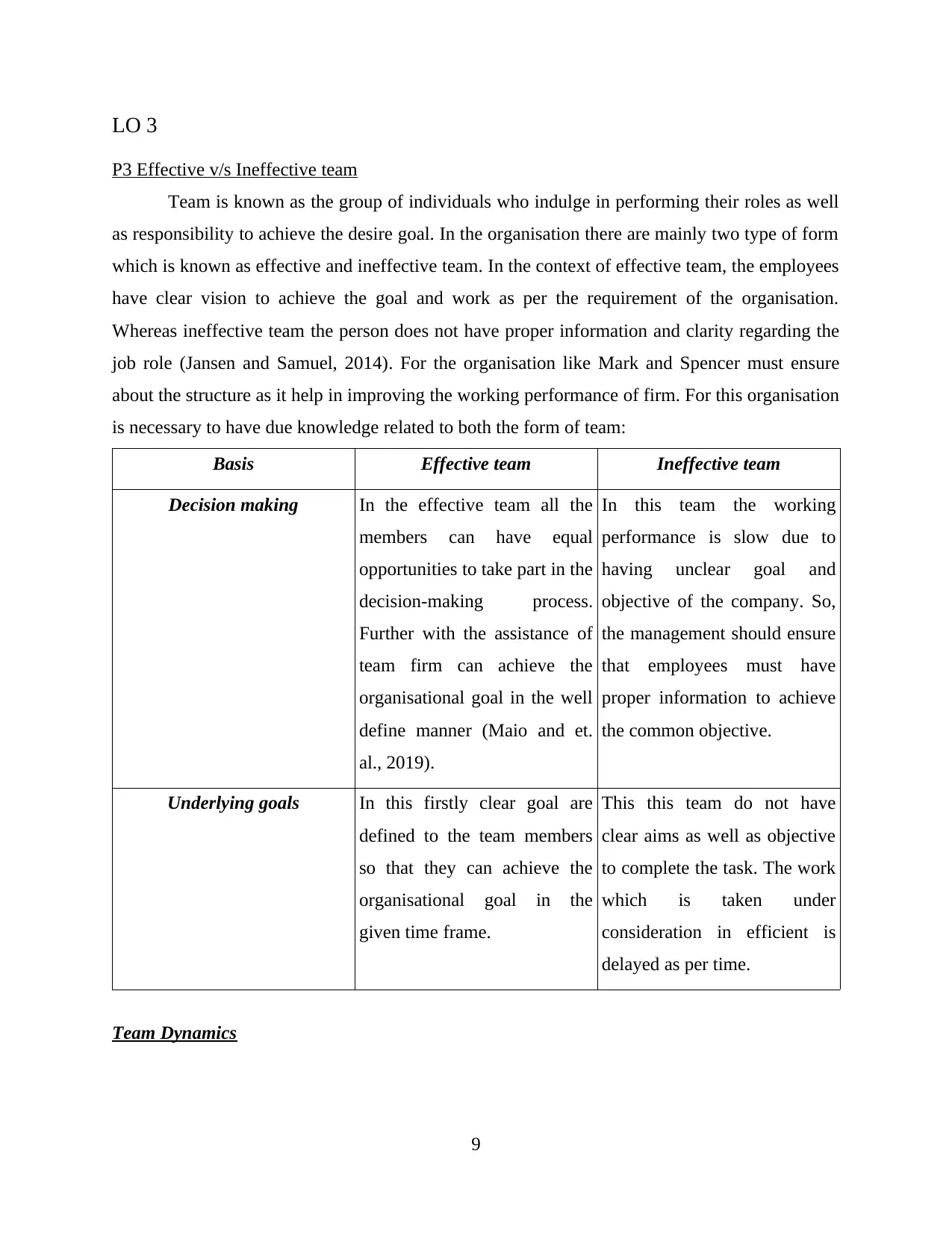
LO 3
P3 Effective v/s Ineffective team
Team is known as the group of individuals who indulge in performing their roles as well
as responsibility to achieve the desire goal. In the organisation there are mainly two type of form
which is known as effective and ineffective team. In the context of effective team, the employees
have clear vision to achieve the goal and work as per the requirement of the organisation.
Whereas ineffective team the person does not have proper information and clarity regarding the
job role (Jansen and Samuel, 2014). For the organisation like Mark and Spencer must ensure
about the structure as it help in improving the working performance of firm. For this organisation
is necessary to have due knowledge related to both the form of team:
Basis Effective team Ineffective team
Decision making In the effective team all the
members can have equal
opportunities to take part in the
decision-making process.
Further with the assistance of
team firm can achieve the
organisational goal in the well
define manner (Maio and et.
al., 2019).
In this team the working
performance is slow due to
having unclear goal and
objective of the company. So,
the management should ensure
that employees must have
proper information to achieve
the common objective.
Underlying goals In this firstly clear goal are
defined to the team members
so that they can achieve the
organisational goal in the
given time frame.
This this team do not have
clear aims as well as objective
to complete the task. The work
which is taken under
consideration in efficient is
delayed as per time.
Team Dynamics
9
P3 Effective v/s Ineffective team
Team is known as the group of individuals who indulge in performing their roles as well
as responsibility to achieve the desire goal. In the organisation there are mainly two type of form
which is known as effective and ineffective team. In the context of effective team, the employees
have clear vision to achieve the goal and work as per the requirement of the organisation.
Whereas ineffective team the person does not have proper information and clarity regarding the
job role (Jansen and Samuel, 2014). For the organisation like Mark and Spencer must ensure
about the structure as it help in improving the working performance of firm. For this organisation
is necessary to have due knowledge related to both the form of team:
Basis Effective team Ineffective team
Decision making In the effective team all the
members can have equal
opportunities to take part in the
decision-making process.
Further with the assistance of
team firm can achieve the
organisational goal in the well
define manner (Maio and et.
al., 2019).
In this team the working
performance is slow due to
having unclear goal and
objective of the company. So,
the management should ensure
that employees must have
proper information to achieve
the common objective.
Underlying goals In this firstly clear goal are
defined to the team members
so that they can achieve the
organisational goal in the
given time frame.
This this team do not have
clear aims as well as objective
to complete the task. The work
which is taken under
consideration in efficient is
delayed as per time.
Team Dynamics
9
⊘ This is a preview!⊘
Do you want full access?
Subscribe today to unlock all pages.

Trusted by 1+ million students worldwide
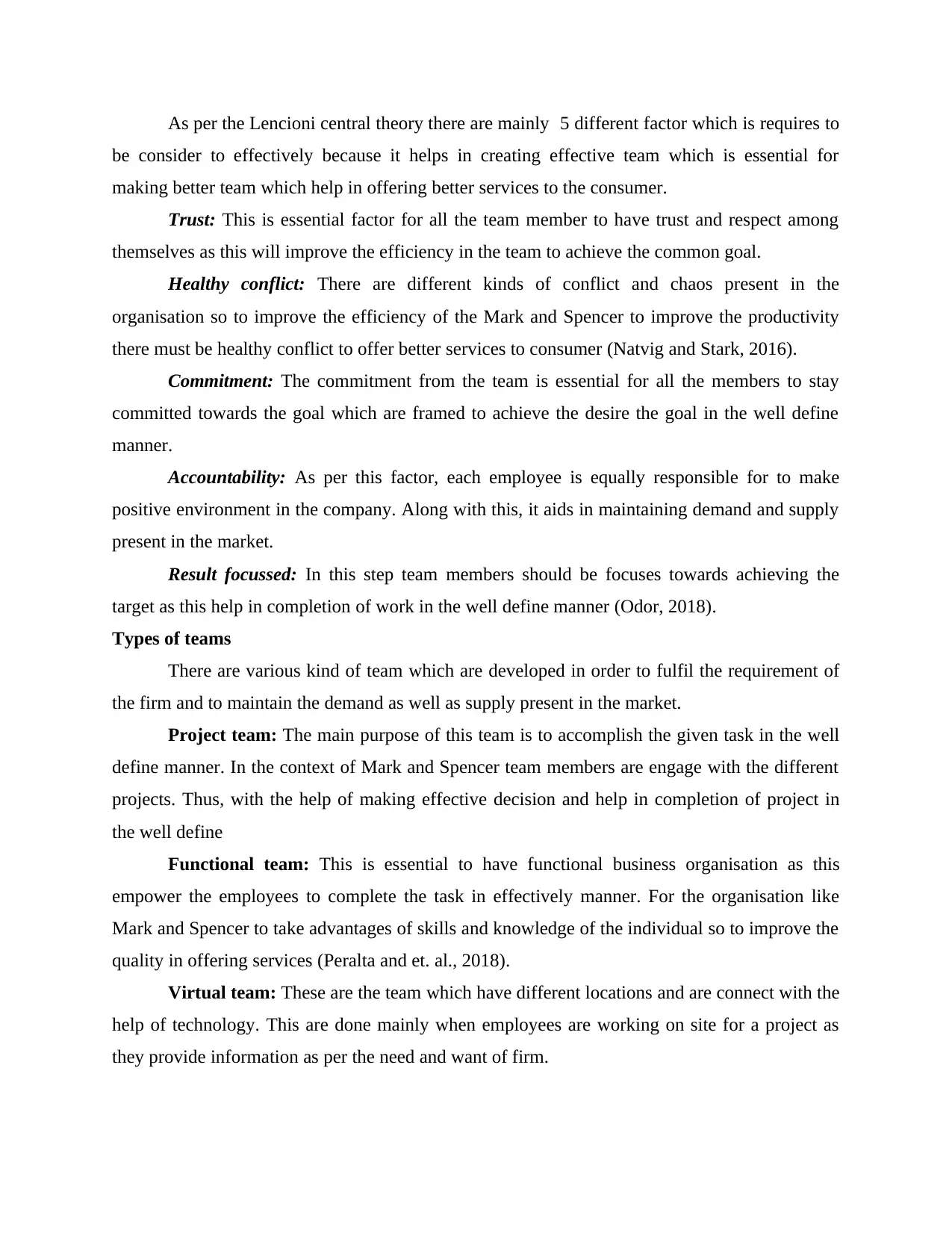
As per the Lencioni central theory there are mainly 5 different factor which is requires to
be consider to effectively because it helps in creating effective team which is essential for
making better team which help in offering better services to the consumer.
Trust: This is essential factor for all the team member to have trust and respect among
themselves as this will improve the efficiency in the team to achieve the common goal.
Healthy conflict: There are different kinds of conflict and chaos present in the
organisation so to improve the efficiency of the Mark and Spencer to improve the productivity
there must be healthy conflict to offer better services to consumer (Natvig and Stark, 2016).
Commitment: The commitment from the team is essential for all the members to stay
committed towards the goal which are framed to achieve the desire the goal in the well define
manner.
Accountability: As per this factor, each employee is equally responsible for to make
positive environment in the company. Along with this, it aids in maintaining demand and supply
present in the market.
Result focussed: In this step team members should be focuses towards achieving the
target as this help in completion of work in the well define manner (Odor, 2018).
Types of teams
There are various kind of team which are developed in order to fulfil the requirement of
the firm and to maintain the demand as well as supply present in the market.
Project team: The main purpose of this team is to accomplish the given task in the well
define manner. In the context of Mark and Spencer team members are engage with the different
projects. Thus, with the help of making effective decision and help in completion of project in
the well define
Functional team: This is essential to have functional business organisation as this
empower the employees to complete the task in effectively manner. For the organisation like
Mark and Spencer to take advantages of skills and knowledge of the individual so to improve the
quality in offering services (Peralta and et. al., 2018).
Virtual team: These are the team which have different locations and are connect with the
help of technology. This are done mainly when employees are working on site for a project as
they provide information as per the need and want of firm.
be consider to effectively because it helps in creating effective team which is essential for
making better team which help in offering better services to the consumer.
Trust: This is essential factor for all the team member to have trust and respect among
themselves as this will improve the efficiency in the team to achieve the common goal.
Healthy conflict: There are different kinds of conflict and chaos present in the
organisation so to improve the efficiency of the Mark and Spencer to improve the productivity
there must be healthy conflict to offer better services to consumer (Natvig and Stark, 2016).
Commitment: The commitment from the team is essential for all the members to stay
committed towards the goal which are framed to achieve the desire the goal in the well define
manner.
Accountability: As per this factor, each employee is equally responsible for to make
positive environment in the company. Along with this, it aids in maintaining demand and supply
present in the market.
Result focussed: In this step team members should be focuses towards achieving the
target as this help in completion of work in the well define manner (Odor, 2018).
Types of teams
There are various kind of team which are developed in order to fulfil the requirement of
the firm and to maintain the demand as well as supply present in the market.
Project team: The main purpose of this team is to accomplish the given task in the well
define manner. In the context of Mark and Spencer team members are engage with the different
projects. Thus, with the help of making effective decision and help in completion of project in
the well define
Functional team: This is essential to have functional business organisation as this
empower the employees to complete the task in effectively manner. For the organisation like
Mark and Spencer to take advantages of skills and knowledge of the individual so to improve the
quality in offering services (Peralta and et. al., 2018).
Virtual team: These are the team which have different locations and are connect with the
help of technology. This are done mainly when employees are working on site for a project as
they provide information as per the need and want of firm.
Paraphrase This Document
Need a fresh take? Get an instant paraphrase of this document with our AI Paraphraser
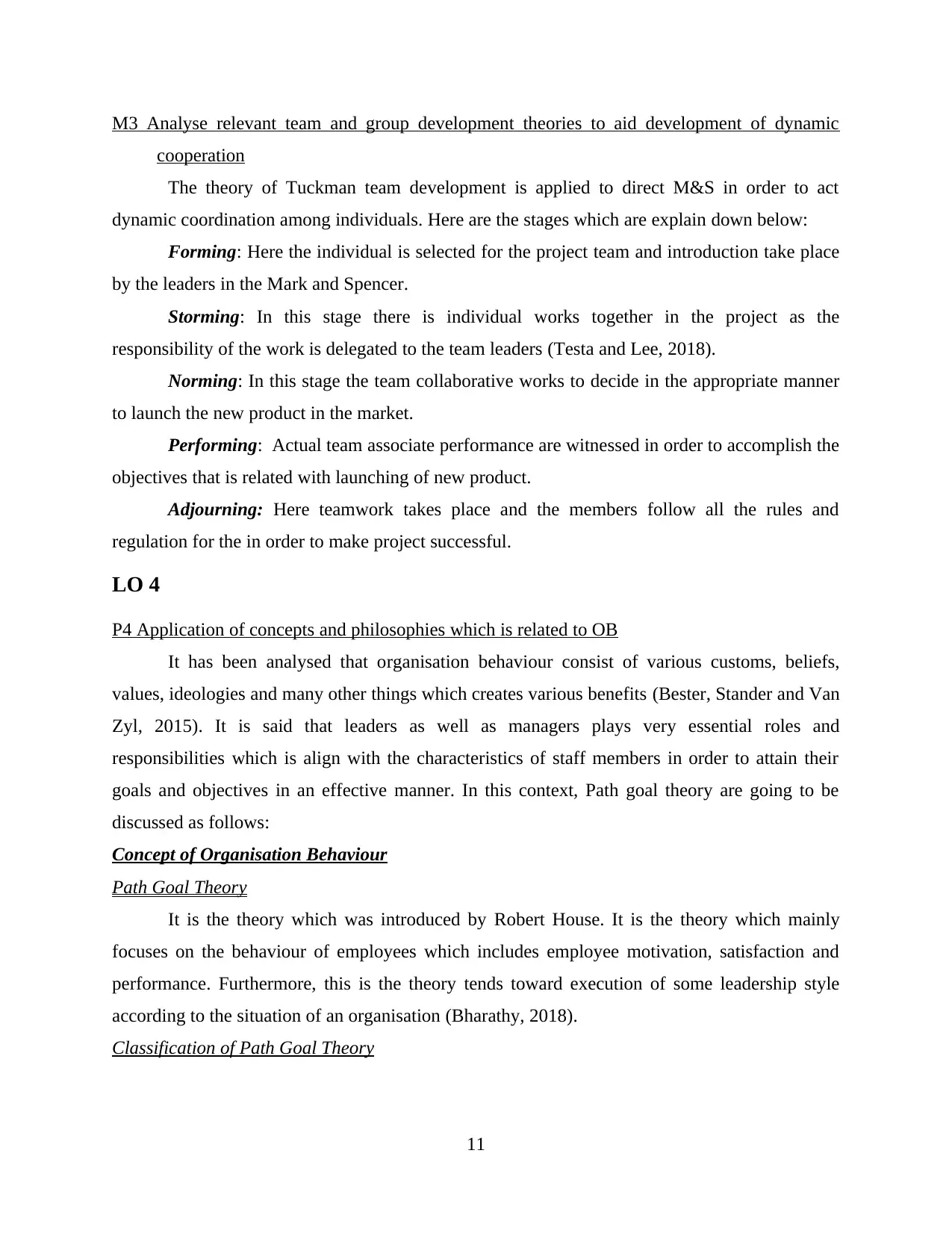
M3 Analyse relevant team and group development theories to aid development of dynamic
cooperation
The theory of Tuckman team development is applied to direct M&S in order to act
dynamic coordination among individuals. Here are the stages which are explain down below:
Forming: Here the individual is selected for the project team and introduction take place
by the leaders in the Mark and Spencer.
Storming: In this stage there is individual works together in the project as the
responsibility of the work is delegated to the team leaders (Testa and Lee, 2018).
Norming: In this stage the team collaborative works to decide in the appropriate manner
to launch the new product in the market.
Performing: Actual team associate performance are witnessed in order to accomplish the
objectives that is related with launching of new product.
Adjourning: Here teamwork takes place and the members follow all the rules and
regulation for the in order to make project successful.
LO 4
P4 Application of concepts and philosophies which is related to OB
It has been analysed that organisation behaviour consist of various customs, beliefs,
values, ideologies and many other things which creates various benefits (Bester, Stander and Van
Zyl, 2015). It is said that leaders as well as managers plays very essential roles and
responsibilities which is align with the characteristics of staff members in order to attain their
goals and objectives in an effective manner. In this context, Path goal theory are going to be
discussed as follows:
Concept of Organisation Behaviour
Path Goal Theory
It is the theory which was introduced by Robert House. It is the theory which mainly
focuses on the behaviour of employees which includes employee motivation, satisfaction and
performance. Furthermore, this is the theory tends toward execution of some leadership style
according to the situation of an organisation (Bharathy, 2018).
Classification of Path Goal Theory
11
cooperation
The theory of Tuckman team development is applied to direct M&S in order to act
dynamic coordination among individuals. Here are the stages which are explain down below:
Forming: Here the individual is selected for the project team and introduction take place
by the leaders in the Mark and Spencer.
Storming: In this stage there is individual works together in the project as the
responsibility of the work is delegated to the team leaders (Testa and Lee, 2018).
Norming: In this stage the team collaborative works to decide in the appropriate manner
to launch the new product in the market.
Performing: Actual team associate performance are witnessed in order to accomplish the
objectives that is related with launching of new product.
Adjourning: Here teamwork takes place and the members follow all the rules and
regulation for the in order to make project successful.
LO 4
P4 Application of concepts and philosophies which is related to OB
It has been analysed that organisation behaviour consist of various customs, beliefs,
values, ideologies and many other things which creates various benefits (Bester, Stander and Van
Zyl, 2015). It is said that leaders as well as managers plays very essential roles and
responsibilities which is align with the characteristics of staff members in order to attain their
goals and objectives in an effective manner. In this context, Path goal theory are going to be
discussed as follows:
Concept of Organisation Behaviour
Path Goal Theory
It is the theory which was introduced by Robert House. It is the theory which mainly
focuses on the behaviour of employees which includes employee motivation, satisfaction and
performance. Furthermore, this is the theory tends toward execution of some leadership style
according to the situation of an organisation (Bharathy, 2018).
Classification of Path Goal Theory
11
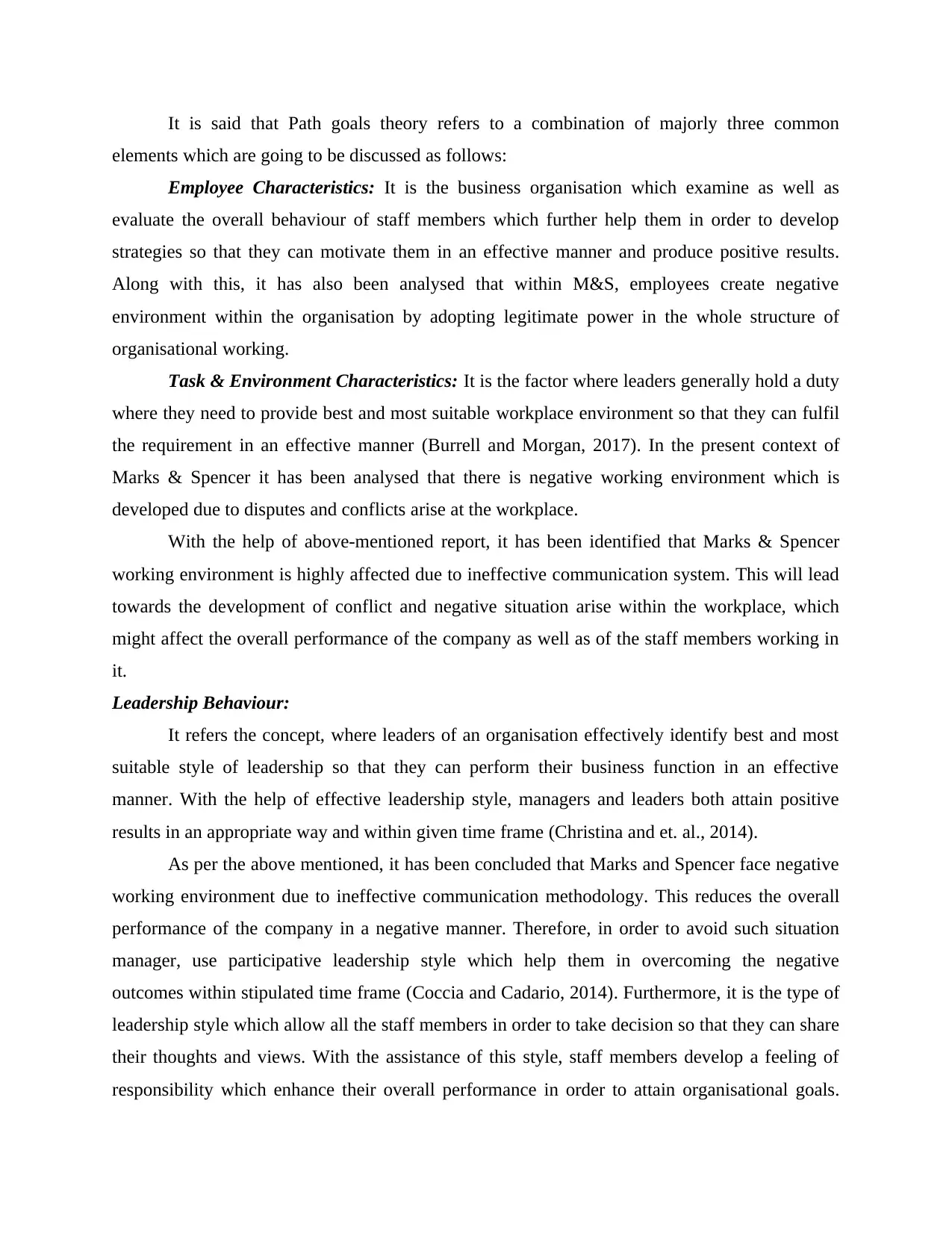
It is said that Path goals theory refers to a combination of majorly three common
elements which are going to be discussed as follows:
Employee Characteristics: It is the business organisation which examine as well as
evaluate the overall behaviour of staff members which further help them in order to develop
strategies so that they can motivate them in an effective manner and produce positive results.
Along with this, it has also been analysed that within M&S, employees create negative
environment within the organisation by adopting legitimate power in the whole structure of
organisational working.
Task & Environment Characteristics: It is the factor where leaders generally hold a duty
where they need to provide best and most suitable workplace environment so that they can fulfil
the requirement in an effective manner (Burrell and Morgan, 2017). In the present context of
Marks & Spencer it has been analysed that there is negative working environment which is
developed due to disputes and conflicts arise at the workplace.
With the help of above-mentioned report, it has been identified that Marks & Spencer
working environment is highly affected due to ineffective communication system. This will lead
towards the development of conflict and negative situation arise within the workplace, which
might affect the overall performance of the company as well as of the staff members working in
it.
Leadership Behaviour:
It refers the concept, where leaders of an organisation effectively identify best and most
suitable style of leadership so that they can perform their business function in an effective
manner. With the help of effective leadership style, managers and leaders both attain positive
results in an appropriate way and within given time frame (Christina and et. al., 2014).
As per the above mentioned, it has been concluded that Marks and Spencer face negative
working environment due to ineffective communication methodology. This reduces the overall
performance of the company in a negative manner. Therefore, in order to avoid such situation
manager, use participative leadership style which help them in overcoming the negative
outcomes within stipulated time frame (Coccia and Cadario, 2014). Furthermore, it is the type of
leadership style which allow all the staff members in order to take decision so that they can share
their thoughts and views. With the assistance of this style, staff members develop a feeling of
responsibility which enhance their overall performance in order to attain organisational goals.
elements which are going to be discussed as follows:
Employee Characteristics: It is the business organisation which examine as well as
evaluate the overall behaviour of staff members which further help them in order to develop
strategies so that they can motivate them in an effective manner and produce positive results.
Along with this, it has also been analysed that within M&S, employees create negative
environment within the organisation by adopting legitimate power in the whole structure of
organisational working.
Task & Environment Characteristics: It is the factor where leaders generally hold a duty
where they need to provide best and most suitable workplace environment so that they can fulfil
the requirement in an effective manner (Burrell and Morgan, 2017). In the present context of
Marks & Spencer it has been analysed that there is negative working environment which is
developed due to disputes and conflicts arise at the workplace.
With the help of above-mentioned report, it has been identified that Marks & Spencer
working environment is highly affected due to ineffective communication system. This will lead
towards the development of conflict and negative situation arise within the workplace, which
might affect the overall performance of the company as well as of the staff members working in
it.
Leadership Behaviour:
It refers the concept, where leaders of an organisation effectively identify best and most
suitable style of leadership so that they can perform their business function in an effective
manner. With the help of effective leadership style, managers and leaders both attain positive
results in an appropriate way and within given time frame (Christina and et. al., 2014).
As per the above mentioned, it has been concluded that Marks and Spencer face negative
working environment due to ineffective communication methodology. This reduces the overall
performance of the company in a negative manner. Therefore, in order to avoid such situation
manager, use participative leadership style which help them in overcoming the negative
outcomes within stipulated time frame (Coccia and Cadario, 2014). Furthermore, it is the type of
leadership style which allow all the staff members in order to take decision so that they can share
their thoughts and views. With the assistance of this style, staff members develop a feeling of
responsibility which enhance their overall performance in order to attain organisational goals.
⊘ This is a preview!⊘
Do you want full access?
Subscribe today to unlock all pages.

Trusted by 1+ million students worldwide
1 out of 17
Related Documents
Your All-in-One AI-Powered Toolkit for Academic Success.
+13062052269
info@desklib.com
Available 24*7 on WhatsApp / Email
![[object Object]](/_next/static/media/star-bottom.7253800d.svg)
Unlock your academic potential
Copyright © 2020–2025 A2Z Services. All Rights Reserved. Developed and managed by ZUCOL.





